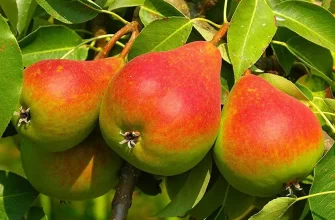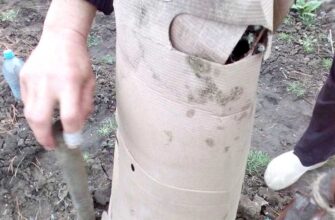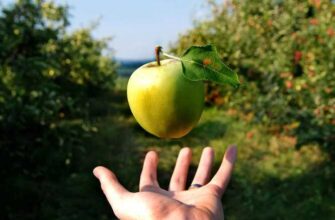- Почему необходима обрезка двухрукавного куста винограда?
- Необходимость обрезки двухрукавного куста винограда
- Когда следует обрезать двухрукавный куст винограда?
- Оптимальное время для обрезки двухрукавного куста винограда
- Как правильно обрезать двухрукавный куст винограда?
- Инструменты, необходимые для обрезки двухрукавного куста винограда
- Основные принципы обрезки двухрукавного куста винограда
- Стратегии обрезки двухрукавного куста винограда для разных сортов
- 1. Чувствительные сорта
- 2. Кусты с мощной лианой
- 3. Сорта с крупными плодами
- Преимущества обрезки двухрукавного куста винограда
- Частые ошибки при обрезке двухрукавного куста винограда
- Какие части куста нужно удалить при обрезке двухрукавного куста винограда?
- 1. Удаление лишних побегов
- 2. Обрезка побегов внутри куста
- 3. Удаление старых и поврежденных веток
- Секреты успешной обрезки двухрукавного куста винограда
- 1. Правильное формирование куста
- 2. Удаление лишних побегов
- 3. Формирование плодовых ветвей
- 4. Поддержание баланса между ростом и плодоношением
- Вопрос-ответ:
- Какие особенности обрезки двухрукавного куста винограда?
- Когда лучше всего обрезать двухрукавный куст винограда?
- Какие инструменты нужны для обрезки двухрукавного куста винограда?
- Какой должна быть длина побегов при обрезке двухрукавного куста винограда?
- Как правильно привязывать побеги двухрукавного куста винограда к опоре?
- Видео:
- Загущенность куста винограда. Не допускайте этого!

Обрезка двухрукавного куста винограда является одной из важных процедур возделывания этого растения. Данный вид обрезки отличается от обычного однорукавного куста своей особенной структурой, которая требует более тщательного подхода.
В отличие от однорукавного куста, двухрукавный куст винограда имеет две главные ветви, которые направлены в противоположные стороны. Это создает определенные сложности при обрезке, так как необходимо соблюдать баланс и равномерное распределение побегов для достижения максимального урожая.
При обрезке двухрукавного куста винограда необходимо удалять все слабые и поврежденные побеги, а также те, которые отходят от ствола под слишком острым углом. Оставшиеся побеги следует сокращать до 2-3 почек, чтобы стимулировать их рост и развитие. Кроме того, необходимо обратить внимание на равномерное распределение побегов по всей поверхности куста.
Почему необходима обрезка двухрукавного куста винограда?

Обрезка двухрукавного куста винограда является важной составляющей его ухода и поддержания оптимальных условий для роста и плодоношения. Этот вид обрезки имеет свои особенности, необходимые для достижения высоких урожаев и здоровья растения.
Особенности двухрукавного куста винограда:
- Куст винограда имеет два основных побега, называемых рукавами. Один из них является основным, а второй — запасным.
- Такая структура куста позволяет растению быть устойчивым к возможным повреждениям, например, от морозов или болезней.
- Каждый рукав образует свои побеги и грозди, что позволяет получить большее количество ягод и улучшить их качество.
Обрезка двухрукавного куста винограда имеет ряд преимуществ:
- Сохранение оптимальной структуры куста позволяет растению эффективно распределять питательные вещества и воду.
- Удаление лишних побегов и листьев способствует лучшей освещенности гроздей, повышая их качество и уменьшая вероятность развития гнили и заболеваний.
- Обрезка стимулирует рост новых побегов, которые будут давать урожай в следующем сезоне.
Таким образом, обрезка двухрукавного куста винограда является неотъемлемой частью заботы о растении и способствует его здоровью и высокой плодовитости.
Необходимость обрезки двухрукавного куста винограда
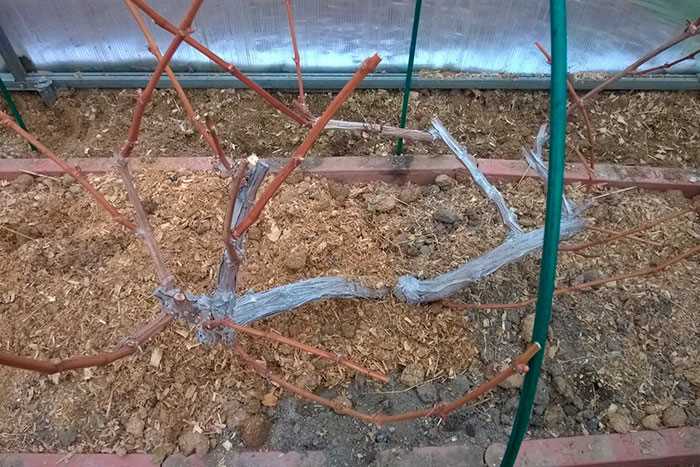
Обрезка двухрукавного куста винограда является неотъемлемой частью ухода за виноградной лозой. Это важная процедура, которая помогает поддерживать растение в хорошей форме и обеспечивает его здоровый рост и развитие.
Одной из особенностей двухрукавного куста винограда является наличие двух главных побегов, которые при обрезке нужно правильно формировать. Один побег является продолжением стебля, а второй — боковым побегом. Такая конструкция позволяет увеличить урожайность и улучшить качество ягод.
Основная цель обрезки двухрукавного куста винограда — создание оптимальной формы куста и поддержание равновесия между его основными частями. При правильной обрезке удается достичь необходимой вентиляции и освещенности растения, что способствует более эффективному фотосинтезу и формированию крупных и сочных ягод.
Необрезанный двухрукавный куст винограда может стать причиной множества проблем. Во-первых, необрезанные побеги могут перекрывать друг друга и создавать недостаток доступа к свету и воздуху. Это может привести к развитию грибковых заболеваний и поражению растения вредителями. Во-вторых, нерегулируемый рост побегов может привести к перегруженности куста, что негативно сказывается на его урожайности.
В итоге, обрезка двухрукавного куста винограда играет важную роль в поддержании здоровья и продуктивности растения. Это дает возможность создать оптимальные условия для его роста и развития, а также получить хороший урожай крупных и вкусных ягод.
Когда следует обрезать двухрукавный куст винограда?

Особенности обрезки двухрукавного куста винограда определяются его фазой развития и климатическими условиями. Существует несколько оптимальных периодов для проведения обрезки, которые помогут достичь наилучших результатов в выращивании винограда.
Весенняя обрезка. Наиболее распространенным временем для обрезки двухрукавного куста винограда является весенний период. Обычно это делается в начале марта, когда снег начинает таять и земля прогреваться. В этот момент соки в растении начинают двигаться, и обрезка поможет значительно улучшить рост и плодоношение винограда.
Осенняя обрезка. Еще одним оптимальным временем для обрезки двухрукавного куста винограда является осенний период. После сбора урожая в сентябре-октябре рекомендуется провести обрезку, чтобы удалить ненужные, поврежденные или больные ветви. Это позволит предотвратить распространение болезней и сохранить растение в хорошем состоянии на зиму.
Подрезка ветвей. В течение всего года, при необходимости, можно проводить подрезку отдельных ветвей двухрукавного куста винограда. Например, если ветви заросли или стали длинными, их можно подрезать, чтобы сохранить компактность куста и улучшить доступ света и воздуха к плодам.
Важно помнить, что каждая фаза обрезки виноградного куста имеет свои особенности и требует определенных навыков и знаний. Поэтому, для достижения наилучших результатов, рекомендуется обратиться к специалистам или изучить дополнительную литературу по обрезке винограда.
Оптимальное время для обрезки двухрукавного куста винограда
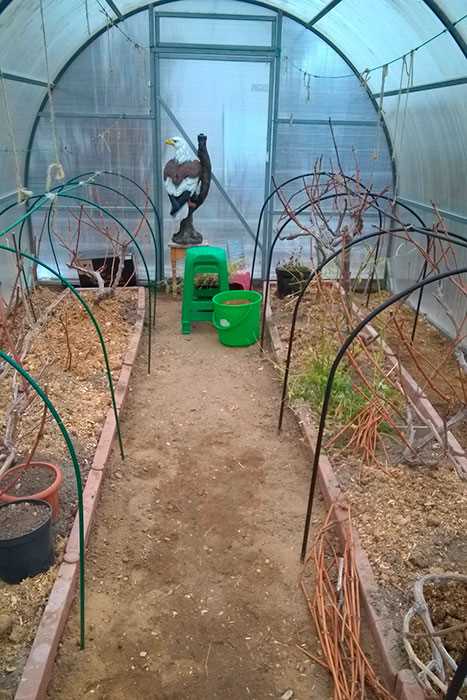
Обрезка двухрукавного куста винограда является важной процедурой для поддержания его здоровья и урожайности. Однако, чтобы достичь наилучших результатов, необходимо знать оптимальное время для проведения этого мероприятия.
Особенностью двухрукавного куста винограда является его структура, состоящая из двух главных побегов или «рукавов». Один рукав формируется в прошлом году, а второй растет в текущем сезоне. Обрезка проводится с целью сохранить баланс между рукавами и обеспечить оптимальное распределение питательных веществ.
Оптимальное время для обрезки двухрукавного куста винограда приходится на конец зимы или начало весны, когда растение находится в период покоя. В это время легче определить, какие побеги нужно удалить, чтобы достичь желаемой структуры куста. Также ранняя обрезка способствует ранней активации роста растения и формированию новых побегов.
При обрезке двухрукавного куста винограда важно учитывать также погодные условия. Не рекомендуется проводить обрезку во время морозов или сильных дождей, так как это может негативно сказаться на здоровье растения. Лучше выбрать солнечный и сухой день для работы.
Как правильно обрезать двухрукавный куст винограда?
Особенности двухрукавного куста винограда
Двухрукавный куст винограда представляет собой особую форму обрезки, которая обеспечивает оптимальное развитие и урожайность растения. Такой куст состоит из двух главных побегов – длинного вертикального стебля и бокового побега. Основная особенность такого куста заключается в том, что оба побега имеют равное значение и способствуют развитию виноградной лозы.
Правила обрезки двухрукавного куста
Обрезка двухрукавного куста винограда включает в себя несколько важных правил:
- Удаление старых и поврежденных побегов. Это позволяет освободить место для развития новых и здоровых веток.
- Обрезка вертикального стебля. Он должен быть укорочен, оставляя 2-3 сильных почки. Это способствует росту новых побегов и формированию новых главных побегов в следующем сезоне.
- Обрезка бокового побега. Его необходимо укоротить на 2/3 длины, оставив 2-3 почки на каждом участке. Это обеспечивает равномерное развитие и урожайность куста.
- Удаление лишних побегов. Если на кусте образуется слишком много побегов, их нужно удалить, чтобы избежать конкуренции и перегруженности растения.
Полезные советы по обрезке двухрукавного куста
При обрезке двухрукавного куста винограда рекомендуется следовать следующим советам:
- Проводите обрезку в период покоя растения, в конце зимы или ранней весной.
- Используйте острые и чистые садовые инструменты для обрезки, чтобы избежать повреждения растения.
- Поддерживайте регулярность обрезки, проводя ее каждый год, чтобы обеспечить здоровое развитие и урожайность куста.
Соблюдение этих рекомендаций поможет вам правильно обрезать двухрукавный куст винограда и получить хороший урожай винограда.
Инструменты, необходимые для обрезки двухрукавного куста винограда
Обрезка двухрукавного куста винограда является важной процедурой для поддержания его здоровья и повышения урожайности. Для выполнения этой задачи вам понадобятся определенные инструменты, которые помогут вам сделать обрезку более эффективной и безопасной.
Один из основных инструментов для обрезки винограда — это секатор. Секатор представляет собой ручной инструмент с острыми лезвиями и пружинным механизмом, который позволяет вам с легкостью обрезать ветки винограда без лишнего усилия. Он также обеспечивает чистый и аккуратный срез, что важно для предотвращения повреждения растения.
Для обрезки более крупных веток вам может понадобиться ручная пила. Ручная пила имеет длинное лезвие с зубьями, которые позволяют вам легко прорезать более толстые ветки. При выборе ручной пилы обратите внимание на ее качество и остроту лезвия, чтобы обеспечить чистый и точный срез.
Кроме того, вам могут понадобиться перчатки для защиты рук при обрезке винограда. Перчатки помогут предотвратить возможные порезы и ушибы, а также защитят ваши руки от контакта с различными вредителями, которые могут быть на ветках и листьях.
Не забудьте также о дезинфекции инструментов перед и после обрезки. Для этого вы можете использовать специальные средства для дезинфекции или просто протереть лезвия инструментов спиртосодержащим средством. Это поможет предотвратить передачу возможных инфекций или болезней на растения.
Основные принципы обрезки двухрукавного куста винограда
1. Формирование основного ствола: при обрезке двухрукавного куста винограда основной акцент делается на формировании двух основных стволов. Один из них будет выступать в качестве «левой руки», а другой — «правой руки». Для этого выбираются два самых сильных побега и они оставляются для формирования будущих стволов.
2. Обрезка боковых побегов: после формирования основных стволов необходимо обрезать боковые побеги на каждом из стволов. Это делается с целью создания оптимальной плотности куста и равномерного распределения плодов на растении. Боковые побеги обрезаются до 2-3 почек.
Так стоп!!! Вы всё ещё не подписаны на наши каналы в Телеграмм и Дзен? Посмотрите: ТГ - (@historyfantasydetectivechat) и Дзен (https://dzen.ru/myshortsstorys)
3. Подвязка стволов: после обрезки побегов необходимо подвязать стволы к опоре. Это поможет укрепить растение и позволит ему расти вертикально, что способствует лучшему питанию и созреванию плодов. Подвязка стволов производится с помощью специальных подвязочных материалов или веревок.
4. Удаление лишних побегов: в процессе роста винограда могут появиться лишние побеги, которые мешают нормальному развитию и плодоношению куста. Поэтому важно регулярно осматривать растение и удалять все лишние побеги. Это позволит сохранить оптимальную плотность куста и повысить качество урожая.
Стратегии обрезки двухрукавного куста винограда для разных сортов

Виноградный куст является сложной системой, которую нужно регулярно обрезать, чтобы достичь оптимального урожая. Особенности обрезки двухрукавного куста винограда зависят от сорта винограда и его особенностей роста.
1. Чувствительные сорта
Некоторые сорта винограда, такие как Рислинг или Шардоне, являются чувствительными к заморозкам и болезням. Для обрезки таких сортов необходимо проводить ее осенью, чтобы предотвратить повреждение побегов во время зимы. Также рекомендуется удалить все сухие и поврежденные ветки, чтобы предотвратить распространение болезней.
2. Кусты с мощной лианой
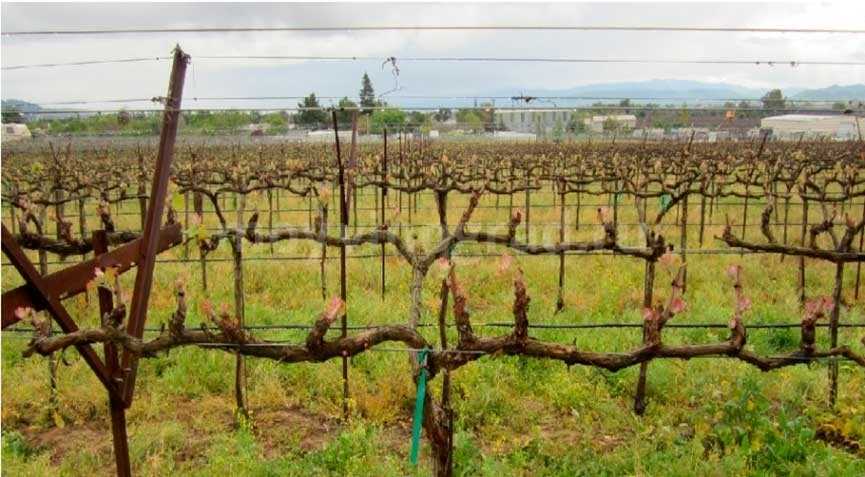
Некоторые сорта винограда имеют мощную и быстрорастущую лиану. Для обрезки таких кустов рекомендуется оставить 1-2 основных побега, которые будут служить основой для формирования куста. В остальном же случае, необходимо удалить все лишние побеги и ветки, чтобы обеспечить хорошую вентиляцию и доступ света к гроздям.
3. Сорта с крупными плодами
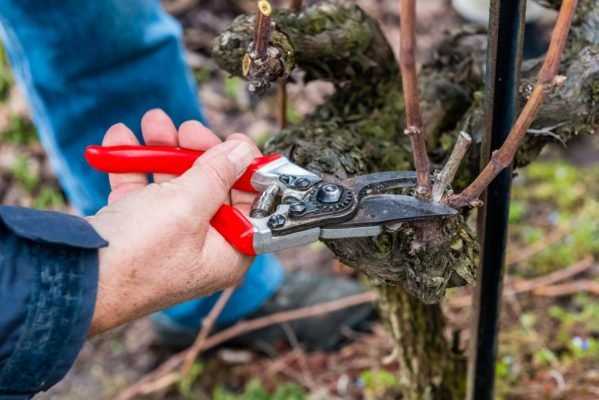
Для сортов винограда с крупными плодами, таких как Каберне Совиньон или Мерло, важно обеспечить оптимальное распределение питательных веществ. Для этого нужно оставить ограниченное количество гроздей, удаляя все лишние. Также рекомендуется обрезать побеги, чтобы уменьшить нагрузку на куст и улучшить качество плодов.
В заключении, обрезка двухрукавного куста винограда должна проводиться с учетом особенностей сорта винограда и его роста. Следуя определенным стратегиям обрезки, можно добиться улучшения урожая, качества плодов и предотвратить распространение болезней.
Преимущества обрезки двухрукавного куста винограда
Обрезка двухрукавного куста винограда имеет свои особенности, которые позволяют получить ряд преимуществ. Во-первых, такая обрезка способствует более равномерному и стабильному росту куста. При правильном выполнении обрезки, виноградный куст достигает оптимальной формы, что позволяет получить более качественные и урожайные грозди.
Во-вторых, обрезка двухрукавного куста способствует улучшению вентиляции и освещения растения. Удаляя лишние побеги и листья, можно создать оптимальные условия для доступа солнечного света и воздуха до гроздей. Это способствует лучшему созреванию ягод и предотвращает развитие гнили и других заболеваний.
Третье преимущество обрезки двухрукавного куста — это возможность контроля над урожаем и его качеством. Удаляя лишние побеги, можно сосредоточить питательные вещества на основных гроздях, что обеспечивает их более полноценное развитие. Кроме того, обрезка позволяет удерживать размер гроздей в определенных пределах, что положительно сказывается на их качестве и удобстве их сбора.
Частые ошибки при обрезке двухрукавного куста винограда
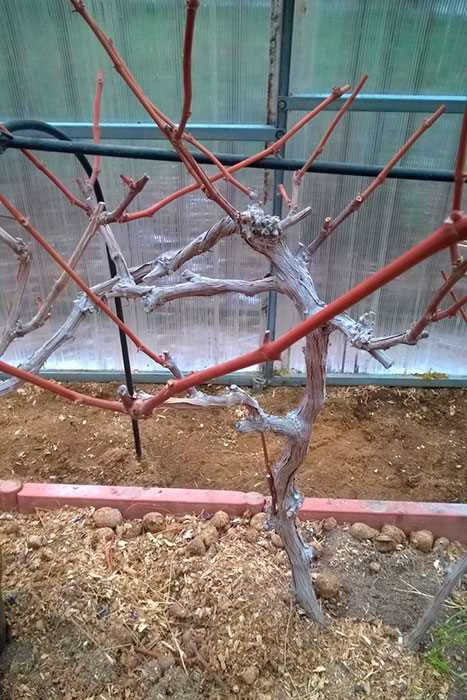
Обрезка двухрукавного куста винограда имеет свои особенности, и существует несколько частых ошибок, которые садоводы могут совершить в процессе.
1. Неправильное определение точки обрезки. Одной из особенностей двухрукавного куста является его структура, состоящая из двух главных побегов. Ошибка может заключаться в неправильном определении места среза побега, что может привести к нежелательным последствиям для роста и развития винограда.
2. Недостаточная обрезка боковых побегов. Виноградный куст имеет множество боковых побегов, которые могут отнимать энергию от центральных побегов. Ошибка состоит в недостаточной обрезке боковых побегов, что может привести к перегруженности куста и плохому созреванию ягод.
3. Слишком сильная обрезка центральных побегов. В процессе обрезки необходимо найти баланс между укорачиванием центральных побегов и сохранением достаточного количества лоз для будущего урожая. Ошибка заключается в слишком сильной обрезке центральных побегов, что может привести к недостаточному развитию куста и уменьшению урожая.
4. Неправильная последовательность обрезки. Важно соблюдать правильную последовательность обрезки побегов, начиная с удаления сухих и поврежденных веток, а затем переходя к формированию куста. Ошибка состоит в неправильной последовательности действий, что может нарушить естественный рост и развитие винограда.
Чтобы избежать этих ошибок, рекомендуется обратиться к специалистам или изучить подробные инструкции по обрезке двухрукавного куста винограда. Правильная обрезка позволит сохранить здоровье и урожайность растения, а также сделает его более устойчивым к болезням и вредителям.
Какие части куста нужно удалить при обрезке двухрукавного куста винограда?

Обрезка двухрукавного куста винограда включает в себя удаление определенных частей куста, чтобы обеспечить его правильный рост и развитие.
1. Удаление лишних побегов
Во время обрезки двухрукавного куста винограда следует удалить все лишние побеги, которые растут с основного стебля. Это позволит кусту сосредоточить свои силы на развитии главных побегов и плодоношении.
2. Обрезка побегов внутри куста

Необходимо также удалить побеги, которые растут внутри куста и направлены внутрь. Это позволит обеспечить хорошую циркуляцию воздуха внутри куста и предотвратить появление болезней.
3. Удаление старых и поврежденных веток

Важной частью обрезки двухрукавного куста винограда является удаление старых и поврежденных веток. Это поможет кусту избавиться от больных и непродуктивных ветвей, а также способствует росту новых здоровых побегов.
Правильная обрезка двухрукавного куста винограда поможет обеспечить его здоровье и урожайность. Помните, что каждый сорт винограда может иметь свои особенности обрезки, поэтому рекомендуется ознакомиться с инструкциями для конкретного сорта или проконсультироваться с опытным садоводом.
Секреты успешной обрезки двухрукавного куста винограда
Двуручный куст винограда – это особый вид формирования виноградной лозы, который позволяет получить богатый урожай и обеспечить куст хорошей вентиляцией. Однако обрезка такого куста требует определенных знаний и навыков. В этой статье мы расскажем вам о некоторых особенностях обрезки двухрукавного куста винограда и поделимся секретами успешного ухода за ним.
1. Правильное формирование куста

Перед началом обрезки необходимо правильно сформировать двухрукавный куст. Для этого выбирают две сильные руки, которые будут служить основой куста. Остальные побеги и ветви удаляются, чтобы оставить только две основные, на которых будут развиваться плоды.
2. Удаление лишних побегов
В процессе роста винограда на двухрукавном кусте могут появляться лишние побеги. Они могут конкурировать с основными побегами и забирать у них питательные вещества. Поэтому важно регулярно проверять и удалять все лишние побеги, оставляя только самые сильные и здоровые.
3. Формирование плодовых ветвей
Для того чтобы виноград хорошо развивался, необходимо правильно формировать плодовые ветви. Они должны быть расположены на основных руках куста, равномерно распределены и иметь достаточное количество света и воздуха для нормального развития плодов.
4. Поддержание баланса между ростом и плодоношением
Одной из основных задач обрезки двухрукавного куста винограда является поддержание баланса между ростом и плодоношением. Для этого необходимо правильно распределить нагрузку на побеги, удалять лишние плоды и обеспечить кусту достаточное количество питательных веществ.
В заключение, обрезка двухрукавного куста винограда – это важный и ответственный процесс, который требует некоторых знаний и определенных навыков. Следуя приведенным секретам, вы сможете успешно формировать и ухаживать за таким кустом, получая богатый и качественный урожай.
Вопрос-ответ:
Какие особенности обрезки двухрукавного куста винограда?
Основная особенность обрезки двухрукавного куста винограда заключается в том, что куст формируется из двух побегов, которые привязываются к опоре в разные стороны.
Когда лучше всего обрезать двухрукавный куст винограда?
Лучшее время для обрезки двухрукавного куста винограда приходится на конец зимы или начало весны, до начала активного роста виноградной лозы.
Какие инструменты нужны для обрезки двухрукавного куста винограда?
Для обрезки двухрукавного куста винограда необходимы секаторы, пилка и веревка или проволока для привязывания побегов к опоре.
Какой должна быть длина побегов при обрезке двухрукавного куста винограда?
Побеги при обрезке двухрукавного куста винограда следует оставлять длиной около 1 метра, чтобы обеспечить достаточно места для развития и роста лозы.
Как правильно привязывать побеги двухрукавного куста винограда к опоре?
Побеги двухрукавного куста винограда следует привязывать к опоре, растягивая их в разные стороны и фиксируя веревкой или проволокой. Привязывать побеги нужно так, чтобы они не перекрывали друг друга и имели достаточно места для роста.


